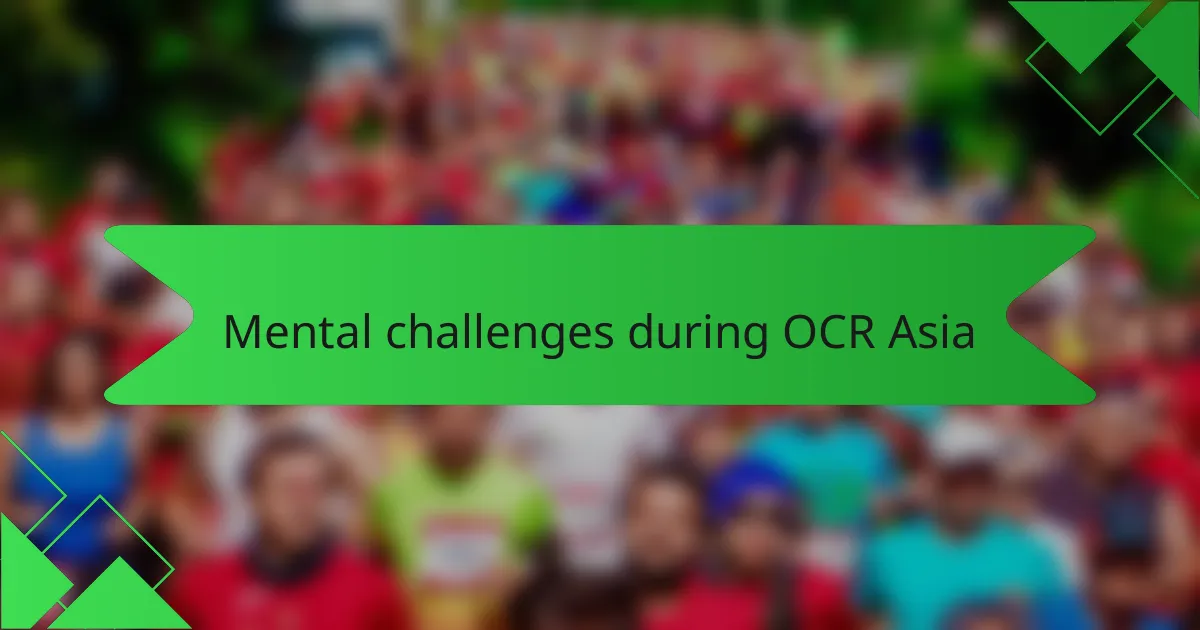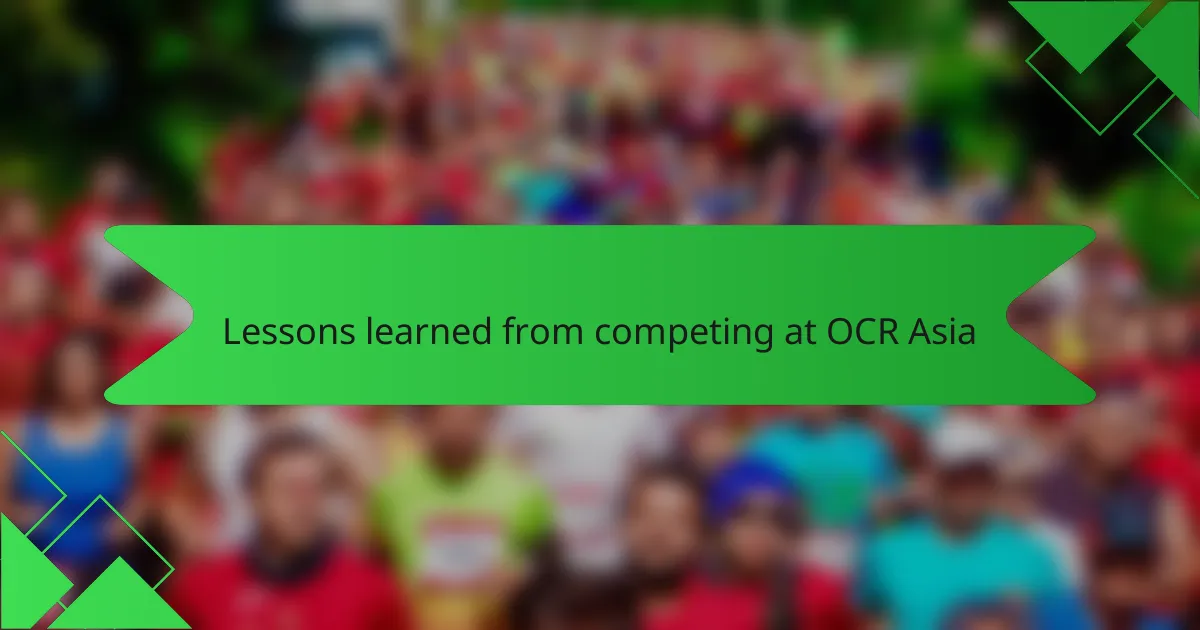Key takeaways
- Obstacle course racing (OCR) combines physical challenges with mental grit, promoting problem-solving and perseverance.
- Preparing for OCR requires a focus on functional strength, endurance training, and proper recovery techniques.
- Choosing the right gear significantly enhances performance by ensuring comfort and support during challenging terrains.
- Mental resilience and adaptability are crucial, enabling athletes to overcome obstacles and thrive in unpredictable environments.

What is obstacle course racing
Obstacle course racing, or OCR, is a sport where you don’t just run — you tackle physical challenges mixed right into the course. Think climbing walls, crawling under nets, jumping over fire, or swinging across monkey bars. It’s a wild combination of strength, endurance, and mental grit, all tested in one race.
When I first tried OCR, I quickly realized it’s not just about speed; it’s about problem-solving in real time and pushing past your own limits. Have you ever felt that rush when you overcome something that seemed impossible? That’s exactly what OCR delivers—it challenges your body and mind in ways a simple run never could.
What fascinates me most is how OCR is inclusive yet fiercely competitive. Whether you’re a seasoned athlete or a complete newbie, each obstacle demands focus and creativity. Doesn’t that mix sound energizing? It’s this dynamic nature that keeps pulling me back for each race.

Overview of OCR Asia events
OCR Asia events bring together an incredible mix of challenges that test every part of your being – from sheer strength to sharp strategy. When I first joined, I was blown away by how diverse the courses are, each designed to push you differently. Have you ever faced an obstacle that made you stop and rethink your entire approach? That moment of recalibrating on the fly is what makes OCR Asia so thrilling.
What strikes me about these events is how they blend culture, terrain, and community. Racing along sandy beaches one day and rugged trails the next keeps everything fresh and unpredictable. Plus, the camaraderie here is something special – it’s not just about beating the clock; it’s about sharing that warrior spirit with people who understand exactly what you’re going through.
One thing I’ve learned is that OCR Asia isn’t just a physical contest – it’s a mental battlefield. Every event I’ve competed in forced me to dig deeper than I thought possible. Have you ever left a race feeling exhausted yet proud in a way you didn’t expect? That feeling is what hooks me every time.

Preparing physically for OCR Asia
Preparing physically for OCR Asia meant I had to rethink my entire training approach. Instead of just running long distances, I focused a lot on building functional strength—think pull-ups, grip training, and explosive movements. I remember struggling with monkey bars at first; it wasn’t about being fast but about having the grip endurance to conquer them without feeling my hands give out.
Endurance was another piece of the puzzle. I found mixing trail runs with interval sprints made a huge difference. It wasn’t easy juggling both stamina and strength, but I noticed how my body adapted—less fatigue on those demanding obstacle sections and more energy to push through. Have you ever surprised yourself by doing more reps or running longer than you thought possible? That’s the kind of progress that kept me motivated.
Recovery also became a key focus. I realized that ignoring rest days left me more prone to injuries, especially with the intense nature of OCR Asia courses. Stretching, foam rolling, and sleep were non-negotiables to keep my body in peak shape. What’s the point of pushing hard if your body can’t hold up when race day arrives? Taking care of myself physically was just as important as the workouts themselves.

Choosing the right gear for OCR Asia
Choosing the right gear for OCR Asia was crucial in my experience, as the course combines muddy terrains, water obstacles, and steep climbs that can quickly drain your energy. I found that lightweight, durable clothing made a huge difference—anything too heavy or restrictive just weighed me down and slowed my pace. The right shoes with excellent grip gave me the confidence to tackle slippery rocks without second-guessing each step.
Based on what I learned, here’s a list of essential gear that worked well for me during OCR Asia:
- Trail running shoes with aggressive tread for mud and wet rocks
- Moisture-wicking, quick-dry clothing to stay comfortable during water obstacles
- Compression socks to protect against scratches and help with muscle support
- Lightweight gloves with good grip for climbing and crawling through ropes
- A hydration pack that’s snug but doesn’t bounce around
- A durable headband or hat to keep sweat and mud out of your eyes
Choosing gear with these features kept me focused on the race rather than my discomfort, which I think anyone competing at OCR Asia should consider.

Nutrition strategies for race day
Nutrition strategies for race day
From my experience competing at OCR Asia, fueling properly on race day is a game-changer. I noticed that a solid breakfast with a balance of carbs and protein kept my energy steady through tough obstacles. Skipping or under-fueling left me drained halfway through, so I learned to stick to familiar foods that wouldn’t upset my stomach.
Hydration is another piece of the puzzle I take very seriously. I drink small amounts of water consistently before and during the race to avoid cramps without feeling bloated. Here are the key nutrition strategies that helped me perform my best:
- Eat a carb-rich breakfast 2-3 hours before the race
- Include moderate protein for sustained energy
- Avoid high-fat and high-fiber foods that can cause discomfort
- Sip water regularly but don’t overhydrate
- Use electrolyte drinks if racing in hot conditions
- Pack easily digestible snacks like energy gels or bars for mid-race boosts
These tactics helped me stay fueled and focused through every grueling part of the course.

Mental challenges during OCR Asia
Mental toughness really takes center stage during OCR Asia. I remember facing an obstacle that seemed impossible at first—I had to convince myself to keep trying, fight off the doubt, and stay calm despite the frustration. Have you ever noticed how your mind races faster than your legs at moments like that? It’s a mental battle almost as intense as the physical one.
What surprised me was how quickly fatigue crept into my head, not just my muscles. When my arms burned or my legs wobbled, my brain started whispering, “Maybe you should quit.” Overcoming those nagging thoughts took deliberate focus and a refusal to give in. Isn’t it wild how much strength it takes just to silence that inner voice and push forward?
Another mental challenge for me was dealing with unpredictability. OCR Asia courses can throw you curveballs with unexpected terrain or obstacles you’ve never seen before. That feeling of stepping into the unknown can be nerve-wracking, but it also taught me to embrace uncertainty and think on my feet. Don’t you think overcoming those mental hurdles gives you a unique kind of confidence that sticks with you long after the race?

Lessons learned from competing at OCR Asia
Lessons learned from competing at OCR Asia have been invaluable to me. One key takeaway was the importance of mental stamina—pushing through tough obstacles isn’t just about physical strength but also about mindset. I remember facing a particularly challenging rope climb; at first, I doubted I could finish, but focusing on one move at a time helped me overcome the fear.
Another lesson was the necessity of proper preparation specific to the unique terrain and obstacles at OCR Asia. I realized that training in environments similar to the race made a huge difference in my confidence and performance. It also taught me the value of adapting quickly, as the courses often throw unexpected challenges your way.
| Lesson | Impact |
|---|---|
| Mental Stamina | Helped me overcome doubt and finish difficult obstacles. |
| Environmental Preparation | Boosted confidence by training for specific terrain and obstacles. |
| Adaptability | Improved ability to handle unexpected challenges during the race. |
